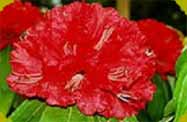|
Clematis montana
Hamilt. ex. Dc.

|
Species |
Clematis montana
Hamilt. ex. Dc. |
|
Local Name |
|
|
Synonym |
Clematis nepaulensis DC |
|
Family |
Ranunculaceae |
|
Habitat |
An evergreen climber found in shady moist ravines |
|
Distribution |
Distributed to temperate regions. |
|
Sikkim |
Kyangnosla, Legship, Yumthang, Bakhim, Memenchu. |
|
Out side |
West Bengal (Ramam, Sirikhola, Sinchel, Tonglu,
Darjeeling), temperate Himalayas from Garhwal to Bhutan,
Kumaon (4500- 7000 feet). |
|
General |
Afghanistan, Himalaya (Kashmir- Bhutan), Meghalaya, West
& Central China, and Taiwan. |
|
Morphological |
An evergreen climber with spreading stems often forming
dense masses and attaining up to 12 m high and 20 mm
diameter. Bark pale brown, rough, exfoliating in loose
fibrous strips. Leaves mostly fascicled on arrested
branches, trifoliate. Petiole usually 2.5- 5 cm long,
sometimes less. Leaflets variable, 3.8- 12.7 by 0.7- 3
cm, entire or more or less deeply 3- lobed, sometimes
to the base very membranous, usually lanceolate or
linear lanceolate, acute, glabrous, glossy beneath.
Flowers greenish, on axillary fascicled, slender,
drooping peduncles 2.5- 6.3 cm long. Sepals 15- 18 mm
long, erect, densely silky-pubescent outside. Filaments
glabrous, pink. Anthers lilac. Peduncles with two
connate membranous green bracts forming a cup about 6mm
below the flower (12- 20 mm below the fruit) sometimes
enlarged foliacioius, achenes hairy; style exceeding 2.5
cm. |
|
Flowering |
June-October |
|
Fruiting |
August-December |
|
History |
|
|
Parts |
Leaves. |
|
Status |
Low risk |
|
Phytochemistry |
A new triterpenic saponin- clemontanoside A- isolated
from leaves and its structure determined (Phytochemistry
1989, 28, 2511); isolation of pentacosaine, ocatcosanone,
friedelin, β-amyrin, oleanolic acid, β- sitosterol and
its glucoside from leaves and stems (Fitoterapia 1989,
60, 477; ibid. 1993, 64, 472); isolation and structure
elucidation of a new saponin- clemontanoside B- from
leaves (Int. 3. Crude Drug Res. 1990, 28, 39); two
saponins isolated and characterized as 3- 0- β-
ribopyranosyl (1- 3)- α -rhamnosyl(1_2)α -arabinopyranoside-
28- 0- α -L -rhamnopyranosyI(1- 4)- α- D- glucosyl(1-
6)- β- D glucopyrosnoside and 3- 0- ribopyranosyl (1-
3)- α- L- rhamnosyl (1- 2) -α- L-arabinopyranoside of
hederagenin (Int. 3. Crude Drug Res. 1990, 28, 125);
another saponin- clemontanoside C- isolated from stem
and characterized as hederagenin- 3- 0- α-L-
arabinopyranoside and hederagenin -3- 0- α- L-
rhamnopyranosyl (1- 2) -α- L-arabinopyranoside and
hederagenin -3- 0- α- L- rhamnopyranosyl (1- 2) -α- L-arabinopyranoside
also isolated (Phytochemistry 1993, 33, 671); isolation
and structure determination of a new triterpenic
bisglycoside clemontanoside F- from roots (Phytochemistry
l993, 34861). |
|
Agrocultivation |
|
|
Reference |
1. Kirtikar, K.R., B.D. Basu (1993).
Indian Medicinal Plants (Vol. 1). Bishen Singh Mahendra
Pal Singh Dehradun, 4.
2. Progress Report of the Project
"Studies on Medicinal Plants of Sikkim" (1998- 2001).
State Council of Science and Technology for Sikkim. |
|
Medicinal |
Leaves are said to act deleteriously on the skin. |
|
Ayurvedic |
|
|
Unani |
|
|
Traditional |
Its fresh roots are crushed and tightened in a clean
cotton cloth and heated over an oven for two minutes.
During this process, strong fume is produced, the
inhalation of which through nose relieves sinus. (Nepali
System). |
|
Others |
|
|
Prepartation |
|
|
Picture |
|
|
|
|
|

Rhododendron


Amongst the many
floral treaties of Sikkim Himalaya one of the earliest ones may be
found over the genus Rhododendron (Gk. rhodo = red, dendrons = tree
). |
| |
|
|
|

Orchid


Orchid
known for their brilliance in colors, unusual shapes
attractive growth habits, variety in fragrance and
exquisite beauty can attract any nature lovers.
|
| |
|
|
|

Medicinal Plant


Sikkim
with its total geographical area of 7,096 sq km is
bestowed with a huge diversity of flora and fauna.
|
| |
|
|
|
|
|